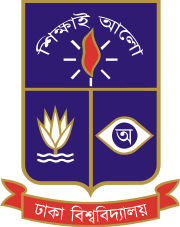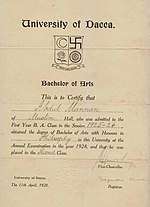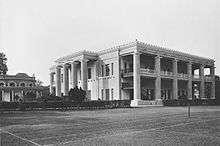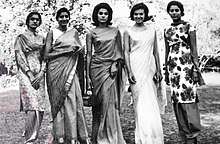University of Dhaka
University of Dhaka (Bengali: ঢাকা বিশ্ববিদ্যালয় [ɖʰaka biʃʃobiddalɔe̯], also known as Dhaka University or DU) is the oldest university in Bangladesh. On the first day of July 1921 the University of Dhaka opened its doors to students with Sir P.J. Hartog as the first Vice-Chancellor of the University in British Raj, it has made significant contributions to the modern history of Bangladesh.[4][5][6][7] After the Partition of India, it became the focal point of progressive and democratic movements in Pakistan. Its students and teachers played a central role in the rise of Bengali nationalism and the independence of Bangladesh in 1971.
ঢাকা বিশ্ববিদ্যালয় | |
 | |
| Motto | শিক্ষাই আলো |
|---|---|
Motto in English | Education is light |
| Type | Public university |
| Established | 1921 |
| Chancellor | Abdul Hamid, President of Bangladesh |
| Vice-Chancellor | Md. Akhtaruzzaman |
Academic staff | 2,156+[1] |
Administrative staff | 3,887[2] |
| Students | 30,015+[1] |
| Undergraduates | 23,000+[3] |
| Postgraduates | 5,362+[3] |
| 764+[3] | |
Other students | 269+[3] |
| Location | , |
| Campus | Urban, 240 hectares (600 acres) (without the Institute of leather engineering and tech.) |
| Website | du |
The university's distinguished alumni include Muhammad Yunus (winner 2006 Nobel Peace Prize, pioneer of Microcredit), Natyaguru Nurul Momen (Pioneer Theatre & Cultural Doyen; who was both an early student & teacher of DU), Muhammad Shahidullah (educator, philologist & linguist), Serajul Islam Choudhury (the country's leading public intellectual and writer), Rehman Sobhan (social democratic economist), Mohammad Ataul Karim (physicist), Abul Fateh (one of the founding fathers of South Asian diplomacy), Buddhadeb Bose (20th-century Bengali poet), and Sheikh Mujibur Rahman (the founding father of Bangladesh). It also enjoyed associations with Satyendra Nath Bose, Vijayaraghavan, and Kazi Nazrul Islam.[8]
Today, it is the largest public research university in Bangladesh, with a student body of 37,018 and a faculty of 1,992. It was identified by AsiaWeek as one of the top 100 universities in Asia.[9] However, since the 1990s, the university has suffered from intensely politicized, partisan, and violent campus politics promoted by Bangladesh's political parties.[10]
History


Before Dhaka University was established, near its grounds were the former buildings of Dhaka College. In 1873 the college was relocated to Bahadur Shah Park. Later it shifted to Curzon Hall, which would become the first institute of the university.[11]
The establishment of the university was a compensation of the annulment of the 1905 Partition of Bengal. The partition had established Muslim majority Eastern Bengal and Assam as a separate province, with Dhaka as its capital. All India Muslim League, newly formed in Dhaka, wholeheartedly supported the move. However, the partition was abolished in 1911 due to severe opposition from Indian National Congress and Bengali Hindus. Deeply hurt by the decision of annulment of Bengal partition, a Muslim delegation led by Nawab Sir Khwaja Salimullah Bahadur, the then Nawab of Dhaka demanded a University be setup in Dhaka. To appease the majority Muslim masses of East Bengal, Lord Curzon agreed and declared that a university as a centre of excellence would be established in Dhaka. Nawab Sir Khwaja Salimullah, the Nawab of Dhaka, who played a pioneering role in establishing the university in Dhaka donated 600 acres of land from his estate for this purpose.[12]
In 1913, public opinion was invited before the university scheme was given its final shape. The secretary of state approved it in December 1913.[11] The first vice-chancellor of the university, Dr. Philip Joseph Hartog, formerly academic registrar of the University of London for 17 years was appointed.[13]
Established in 1921 under the Dacca University Act 1920 of the Indian Legislative Council, it is modelled after British universities. Lord Ronaldshay, Governor of Bengal between 1917 and 1922, was its first chancellor. He designated Nawaab Syed Shamsul Huda a life member of the university. On Huda's recommendation, Lord Ronaldshay appointed Ahmad Fazlur Rahman as a provost.[14] Academic activities started on 1 July in 1921 with 847 students[15] along with 3 faculties: Arts, Science and Law; 12 departments: Sanskrit and Bengali, English, Education, History, Arabic and Islamic Studies, Persian and Urdu, Philosophy, Economics and Politics, Physics, Chemistry, Mathematics, and Law; and 3 dormitories for students: Salimullah Muslim Hall, Dacca Hall and Jagannath Hall.[16]
In 1936, the university awarded honorary doctorate degrees to Jagadish Chandra Bose, Jadunath Sarkar, Sarat Chandra Chattopadhyay, Allama Iqbal and Rabindranath Tagore.[17]
The university played a significant role in the Bengali Language Movement, when Bengalis joined together to fight against Urdu being the official language in East Pakistan. Dhaka University was the main place where the movement started with the students joining together and protesting against the Pakistan government. Later countless students were massacred in where the Shaheed Minar stands today. After the incident, Bengali was restored as official language.[18]
The Dhaka University Order, 1973
President's Order No. 11 of 1973 re-constitute and re-organize the University of Dhaka to improve the teaching and research provided thereby and the administration after 1971 Independence war. Throughout this order, the word Dhaka was substituted for the word Dacca by section 2 of the University Laws (Amendment) Act, 1987 (Act No. XXXVI of 1987).
Campus
Residential facilities
There are 23 residence halls for the students and dormitories for the teachers as well as for the officials of the university.[19]
Libraries
The University Library, housed in three separate buildings, is the biggest in Bangladesh. The library holds a collection of more than 617,000 volumes, including bound volumes of periodicals. In addition, it has a collection of over 30,000 manuscripts in other languages and a large number of microfilms, microfiche and CDs. It subscribes to over 300 foreign journals.[20]
Library Resources Access
The University has access to the subscribed e-resources. Including, Emerald, JStor, IEE Explore and Inasp Perii Consortium Resources. [21]
The Dhaka University Library comprises three buildings: The administrative building, the main library building, and the science library building. The administrative building has the administrative offices, a book acquisition section, a book processing section, a reprographic section, a book binding section, a manuscript section, and a seminar section.[22]
Besides the Faculty of Business Studies of the university has an E-Library which is the largest in the Asia of its kind.[23] This advanced level E-Library is connected with 35 internationally renowned libraries and publication houses in the world. Teachers, students and researchers are able to read all journals, books research papers and articles of these leading libraries, including the Dhaka University, Oxford University and Cambridge University libraries, by using the E-Library facilities.[23]

Health services
The Medical Center of the University of Dhaka, near the Science Annex Building, offers free medical service and free pathological examinations to students, teachers and staff and also family members of the teachers and staffs. The centre provides service round the clock, seven days a week, with 30 doctors working in shifts. The centre has a dental unit, eye unit, X-ray department and two ambulances.[24]
Cafeteria
There are cafeterias on campus, some of which hold historical and architectural interest. In 1971 Pakistani soldiers killed the owner of the Madhur Canteen.[25]
The Teacher-Student Centre, University of Dhaka of the university has its own cafeteria while another cafeteria stands on the Dhaka University Snacks (DUS) chattar. Another one, Science cafeteria was situated behind Curzon Hall, but currently it has been broken down to construct a new 20 storey building. There is also another snacks and lunch place named DU hut in front of the Department of Sociology. The Faculty of Business Studies has a modern food court for its students.[26]
Organization
Research Centers
- Bureau of Economic Research
- Bureau of Business Research
- Bose Center for Advanced Study and Research in Natural Sciences
Faculties
The University consists of 13 Faculties and 83 Departments.[27]
- Faculty of Arts
1. Department of Bangla
2. Department of English
3. Department of Persian Language and Literature
4. Department of Philosophy
5. Department of History
6. Department of Arabic
7. Department of Islamic Studies
8. Department of Islamic History and Culture
9. Department of Sanskrit
10. Department of Information Science and Library Management
11. Department of Language Science
12. Department of Theater and Performance Studies
13. Department of World Religions and Culture
14. Department of Pali and Buddhist Studies
15. Department of Urdu.
16. Department of Linguistics
- Faculty of Business Studies
The Faculty of Business Studies (FBS) was established in 1970 as a Faculty of Commerce. It started the journey with two departments- Department of Accounting and Department of Management. Two more departments were created in 1974 and the authority introduced semester system from the 1977-1978 session. The names of B.Com and M.Com degrees were changed to BBA and MBA respectively during the 1994-95 sessions.[28] Following its re-branding as Faculty of Business Studies, four other departments were added to this Faculty over the course of next thirteen years. In 1995, the faculty of commerce took its current name and became Faculty of Business Studies.[29]
Profile of Dr. Muhammad Abdul Moyeen become the new acting dean of Faculty of Business Studies in May of 2020. [30]
Currently there are nearly 153 teachers, 10 officers, 58 employees and nearly 6100 students under the faculty and the departments are as following.[28]
1. Department of Management Studies
2. Department of Accounting & Information Systems
3. Department of Marketing
4. Department of Finance
5. Department of Banking and Insurance
6. Department of Management Information Systems
7. Department of International Business
8. Department of Tourism and Hospitality Management
9. Department of Organization Strategy and Leadership
- Faculty of Biological Science
1. Department of Soil, Water and Environment
2. Department of Botany
3. Department of Zoology
4. Department of Biochemistry and Molecular Biology
5. Department of Psychology
6. Department of Microbiology
7. Department of Fisheries
8. Department of Medical Psychology
9. Department of Genetic Engineering and Biotechnology
10. Department of Educational Psychology
- Faculty of Engineering and Technology
1. Department of Electrical and Electronic Engineering
2. Department of Applied Chemistry and Chemical Engineering
3. Department of Computer Science & Engineering
4. Department of Nuclear Engineering
5. Department of Robotics and Mechatronics
Constituent Institutes -
- Government
- Private
- National Institute of Textile Engineering and Research,(NITER)
- Shaymoli Textile Engineering College,(STEC)
- Faculty of Fine Arts
- Department of Drawing and Painting
- Department of Graphic Design
- Department of Printmaking
- Department of Oriental Art
- Department of Ceramics
- Department of Sculpture
- Department of Craft
- Department of History of Art
- Faculty of Law
- Department of Law
- Faculty of Medicine
- Bachelor of Physiotherapy(BPT)
- Bachelor of Medicine Bachelor of Surgery (MBBS)
- Bachelor of Dental Surgery (BDS)
- Faculty of Pharmacy
- Department of Pharmaceutical Chemistry
- Department of Clinical Pharmacy and Pharmacology
- Department of Pharmaceutical Technology
- Department of Pharmacy
- Faculty of Science
1. Department of Physics
2. Department of Mathematics
3. Department of Chemistry
4. Department of Biomedical Physics and Technology
5. Department of Theoretical Physics
6. Department of Applied Mathematics
7. Department of Statistics
8. Department of Theoretical and Computational Chemistry
- Faculty of Social Sciences
1. Department of Economics
2. Department of Health Economics
3. Department of Political Science
4. Department of International Relations
5. Department of Anthropology
6. Department of Public Administration
7. Department of Mass Communication and Journalism
8. Department of Communication Disorders
9. Department of Printing and Publication Studies
10. Department of Television, Film and Photography
11. Department of Sociology
12. Department of Development Studies
13. Department of Criminology
14. Department of Japanese Studies
15. Department of Women and Gender Studies
16.Department Of Peace and Conflict Studies
- Faculty of Earth and Environmental Sciences
- Department of Geography and Environment
- Department of Geology
- Department of Oceanography
- Department of Disaster Science and Management
- Department of Meteorology
- Faculty of Education
- Faculty of Postgraduate Medical Sciences and Research
Institutes
%2C_University_of_Dhaka.jpg)
- Institute of Education and Research
- Institute of Statistical Research and Training
- Institute of Business Administration
- Institute of Social Welfare and Research
- Institute of Modern Languages
- Institute of Information Technology
- Institute of Renewable Energy
- Institute of Disaster Management and Vulnerability Studies
- Institute of Health Economics[31]
- Institute of Leather Engineering & Technology
- National Institute of Traumatology and Orthopaedic Rehabilitation
- National Institute of Textile Engineering and Research
- Shyamoli Textile Engineering College (STEC)
- Dhaka Engineering college
- K.M. Humayun Kabir Engineering College
Constituent Colleges
List of colleges under University of Dhaka
Student life

The university of Dhaka organizes sports and other extracurricular and recreational activities. Office of the director of physical education provides three types of programs:
- Compulsory Physical Education,
- Certificate course in coaching major games and sports, and
- Intramural and extramural programs.
University of Dhaka ground is the official stadium of the University of Dhaka. It hosts many inter-collegiate sports tournaments at inter-city and national levels.
Intramural and extramural program
Directorate organizes and conducts interdepartmental and inter-hall tournaments, individual hall athletics, Dhaka university athletics, and inter- university games and sports. Students participate in national championships in games and sports for which prior training and coaching are offered.
Dhaka University Central Students' Union
Dhaka University Central Students' Union is the official students' union of the University of Dhaka. It is better known in Bangladesh as DUCSU. It exists to represent Dhaka University students in the University's decision-making, to act as the voice for students in the national higher education policy debate, and to provide direct services to the student body.[32][33][34] It was established in the academic year of 1922-23 as Dhaka University Student Union. Its first constitution was drafted in its general assembly on 30 October 1925. In 1953, its constitution was amended and the union was renamed Dhaka University Central Students' Union. In 2019, the last DUCSU election took place after 29 years. Since then DUCSU is working for the betterment of the students
Ranking
| University rankings | |
|---|---|
| Global – Overall | |
| QS World[35] | 801-1000 (2021) |
International ranking
In 2011–12, the University of Dhaka made it into the list of 'Top World Universities' by QS World University Rankings. Out of over 30,000 universities around the world, DU was placed at 551.[36] In 2014–15, the University of Dhaka was ranked 701 by QS World University Rankings (formerly Times Higher Education–QS World University Rankings).[37] In 2015–16, Times Higher Education partnering with Elsevier ranked the university at 654th position among top 800 globally reputed universities.[38] In September 2015, QS World University Rankings published their 2015 edition of World University Rankings of 2015/16 and ranked DU at 126th position in Asia and 701-750 position in the world.[39] In 2018 QS World University Rankings, University of Dhaka is ranked in #1300 globally, and based on Graduate Employability, University of Dhaka is placed in #1000+ in the world.[40] In Times Higher Education 2018 Global University Ranking, University of Dhaka is placed in 1001+ position among the world universities.[41]
Asian level ranking
In 2016–17, the University of Dhaka was ranked 109 by QS Asian University Rankings in Asia.[37] Times Higher Education ranked the University of Dhaka at 191-200 position in 2016 Asia University ranking.[42]
In the best Asian (and Australian) universities ranking, AsiaWeek ranked the University of Dhaka 37th in 1999[43] and 64th (overall and multi-disciplinary category) out of 77 ranked universities in 2000.[44]
In 2000, the university got a comparatively higher rank in student selectivity (23rd) while got lower ranking in academic reputation (74th), faculty resources (59th), research (65th) and financial resources (74) categories.[45]
According to the subject wise ranking by the QS World University Rankings by Subject 2015 - English Language & Literature Literature, only two South Asian universities, including University of Dhaka (ranking 250-300), were found in the rankings.[46]
Vice chancellor
The first Vice Chancellor of the University of Dhaka is Sir Philip Hartog.[47] There has been 28 vice chancellors and the current vice chancellor is Prof. Dr. Mohammad Akhtaruzzaman.
Notable alumni and faculty members
See also
- Fazlul Huq Muslim Hall
- Salimullah Muslim Hall
- Dhaka University Library
- Dhaka University Film Society
- Jagannath Hall
- List of Constituent Colleges/Institutes under the University of Dhaka
- Khulna University of Engineering & Technology
- Bangladesh University of Engineering and Technology
- Rajshahi University of Engineering & Technology
- Chittagong University of Engineering & Technology
References
- "Annual Report 2015". University of Dhaka. p. 132.
- http://www.ugc.gov.bd/uploads/2015/annualreport/Part-1-2.zip
- "Annual Report 2015". University of Dhaka. p. 95.
- "Mukherjee 'emotional' while receiving degree in Dhaka". The Economic Times. Retrieved 4 January 2014.
- "In Loving Memory of Samson H. Chowdhury,one of the greatest entrepreneurs the world has ever known". Worldfolio - AFA PRESS. Retrieved 4 January 2014.
- "Nawab Ali Chowdhury National Award, 2013". The News Today. Retrieved 4 January 2014.
- "DU Day". Banglanews24.com. Archived from the original on 3 December 2013. Retrieved 26 November 2013.
- "Satyendra Nath Bose at Dhaka University". Banglapedia. Retrieved 19 February 2015.
- "Asia's Best Universities 2000: University of Dhaka". Asiaweek. 2000. Archived from the original on 28 January 2001. Retrieved 8 October 2013.
- Khan, Kamrul Hasan (16 August 2010). "Student politics eroding Bangladesh campus life". Google. Agence-France Presse. Archived from the original on 28 February 2014. Retrieved 8 October 2013.
- Sajahan Miah (2012). "University of Dhaka". In Sirajul Islam and Ahmed A. Jamal (ed.). Banglapedia: National Encyclopedia of Bangladesh (Second ed.). Asiatic Society of Bangladesh.
- "Khwaja Salimullah". World History. Retrieved 14 May 2015.
- "History of the Formation of Dhaka University". Archived from the original on 31 July 2015. Retrieved 10 February 2016.
- Khan, Muhammad Mojlum (2013). The Muslim Heritage of Bengal. Kube Publishing Ltd. p. 252. ISBN 978-1-84774-059-5.
- University Of Dhaka marks 96 years of glory, The Daily Star.
- "Prospectus of University of Dhaka 2008" (PDF). University of Dhaka. Archived from the original (PDF) on 14 November 2012. Retrieved 16 July 2016.
- "Prof. Razzak: Anti-hero, mentor". The Daily Star. 20 August 2011. Retrieved 19 November 2017.
- "Language Movement". Banglapedia - The National Encyclopedia of Bangladesh. Asiatic Society of Bangladesh. Archived from the original on 7 March 2016. Retrieved 10 February 2016.
- "Halls of Dhaka University". The Independent (Bangladesh newspaper). Dhaka. 6 August 2015. Archived from the original on 9 October 2015. Retrieved 10 February 2016.
- Wedgeworth, Robert (1993). World Encyclopedia of Library and Information Services. American Library Association. p. 102. Archived from the original on 17 February 2017. Retrieved 10 February 2016.
- http://www.library.du.ac.bd
- "Dhaka University a Top Educational Institution in Bangladesh". yogsutra. 28 August 2015. Archived from the original on 10 February 2016. Retrieved 10 February 2016.
- "Asia's largest e-Library opens at Dhaka University". Dhaka Tribune. 11 August 2015. Retrieved 13 September 2015.
- "Dhaka University Medical Center". Archived from the original on 10 February 2016. Retrieved 10 February 2016.
- Yusuf, Ananta. "The Legacy of Madhu's Canteen". The Daily Star. Retrieved 12 July 2015.
- "Mojo Establishes Food Court at Dhaka University". The Daily Star. 26 November 2013. Retrieved 13 September 2015.
- "About University of Dhaka".
- "Head of Office: Prof. Shibli Rubayat Ul Islam". University of Dhaka. University of Dhaka. 15 April 2018. Retrieved 22 June 2018.
- "Faculty of Business Studies". Department of Marketing. Department of Marketing. 10 November 2013. Retrieved 22 June 2018.
- "University of Dhaka || the highest echelon of academic excellence". www.du.ac.bd. Retrieved 13 June 2020.
- http://ihe.ac.bd/
- "The DUCSU conundrum". The Daily Star. 9 October 2017. Retrieved 29 January 2019.
- "Make Ducsu centre of all campus activities". The Daily Star. 16 January 2019. Retrieved 29 January 2019.
- স্মৃতির কঙ্কাল ডাকসু
- [QS ranking 2021 https://www.topuniversities.com/university-rankings/world-university-rankings/2021]
- "QS World University Rankings 2011 (501-600) -Top Universities". University-list.net. Retrieved 8 October 2013.
- "University of Dhaka". University-list.net. Retrieved 28 July 2015.
- "World University Rankings 2016:University of Dhaka". timeshighereducation.com. 2016. Retrieved 19 January 2016.
- "QS Top University Rankings 2015/16:University of Dhaka". QS Intelligence Unit. 2016. Retrieved 21 January 2016.
- [url = https://www.topuniversities.com/universities/university-dhaka#wurs]
- https://www.timeshighereducation.com/world-university-rankings/university-dhaka#ranking-dataset/629337
- "University of Dhaka". The World University Rankings. Retrieved 31 January 2020.
- "ASIANOW | The Asiaweek Best Universities 1999 | The Rankings - Bangladesh". Cgi.cnn.com. 15 April 1999. Archived from the original on 17 February 2001. Retrieved 14 November 2013.
- "Asiaweek.com | Asia's Best Universities 2000 | Overall Ranking". Cgi.cnn.com. 22 June 2000. Archived from the original on 2 February 2016. Retrieved 8 October 2013.
- "Asiaweek.com | Asia's Best Universities 2000 | University of Dhaka". Cgi.cnn.com. 22 June 2000. Archived from the original on 29 April 2001. Retrieved 14 November 2013.
- https://www.topuniversities.com/university-rankings/university-subject-rankings/2015/english-language-literature
- Khan, Muazzam Hussain (2012). "Hartog, Sir Philip Joseph". In Islam, Sirajul; Jamal, Ahmed A. (eds.). Banglapedia: National Encyclopedia of Bangladesh (Second ed.). Asiatic Society of Bangladesh.